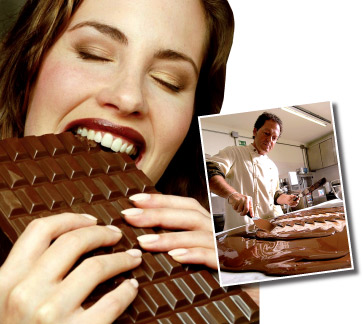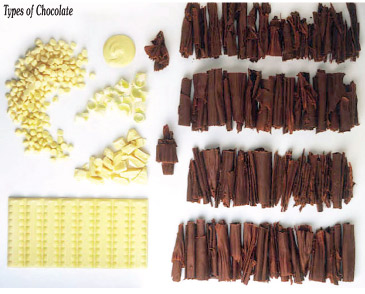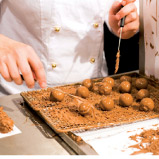Yummy Chocolate
Can you resist the temptation?:
by Prabuddha Athukorala
 It is hard to find many
experiences that outclass the divine taste of a delicious piece of
chocolate melting in inside your mouth. There are a number of stories
attached with the origin of the chocolate and some date way back to the
Mayan civilization. Every mouth watering chocolate we consume starts
from the cocoa bean, the fruit of a tropical tree called ‘theobroma
cacao’. The Swiss and the French were the pioneers in the art of making
chocolates and Linnaeus, a Swedish botanist is credited with the
plantation of cocoa. It is hard to find many
experiences that outclass the divine taste of a delicious piece of
chocolate melting in inside your mouth. There are a number of stories
attached with the origin of the chocolate and some date way back to the
Mayan civilization. Every mouth watering chocolate we consume starts
from the cocoa bean, the fruit of a tropical tree called ‘theobroma
cacao’. The Swiss and the French were the pioneers in the art of making
chocolates and Linnaeus, a Swedish botanist is credited with the
plantation of cocoa.
Chocolates Making
Bean segregation starts as the first step in chocolate making. The
origin of the cocoa bean is very important because regional cocoa beans
have their own distinct taste. Also, there are certain standard
procedures and accepted norms around the world in chocolate production.
The cocoa beans are roasted and skinned, leaving only the centers,
called nibs. These nibs are then pulverized or ground into smooth liquid
called chocolate liquor (although it contains no alcohol).
Chocolate liquor is the basis for all chocolate products. Pure
chocolate liquor is very dark and bitter and has only two components
namely cocoa solids and cocoa butter.
The solids give the chocolate its signature dark colour and strong
flavour whereas the cocoa butter gives it the “melt in the mouth” feel.
Manufacturers learned that by increasing the cocoa butter percentage,
they could create chocolate with a better sheen and smoother texture.
Hence, they developed a high-pressure filter process that breaks down
chocolate liquor which meant that they could manipulate the chocolate to
produce a range of styles and combinations.
Finally, in creating an edible chocolate, sugar and flavourings are
added to the cocoa butter and solids. While some sugar is needed to make
pure chocolate palatable, the best brands contain a high percentage of
real chocolate and only a small amount of sugar and other additives.
Chocolates Types
With advances in the technology the number of chocolate recipes is
always on the rise. Here are some of the most adored brands:
 a. White Chocolate - White chocolate gets its name from the cocoa
butter it contains. Therefore, it has no distinct chocolate taste, but
common tastes like vanilla or other added flavorings. By law, white
chocolate must contain a minimum of 20% cocoa butter; yet there are some
‘white chocolate’ products that contain vegetable fats instead of cocoa
butter. Be careful, these should be avoided as they do not contain any
cocoa products at all, and are not technically white chocolate. a. White Chocolate - White chocolate gets its name from the cocoa
butter it contains. Therefore, it has no distinct chocolate taste, but
common tastes like vanilla or other added flavorings. By law, white
chocolate must contain a minimum of 20% cocoa butter; yet there are some
‘white chocolate’ products that contain vegetable fats instead of cocoa
butter. Be careful, these should be avoided as they do not contain any
cocoa products at all, and are not technically white chocolate.
b. Dark Chocolate – Milk solids are not added in dark chocolate hence
sometimes called ‘plain chocolate’ and ‘black chocolate’. Dark chocolate
can either be sweet, semi-sweet, bittersweet or unsweetened. Cocoa
content of commercial dark chocolate bars can range from 30% (sweet
dark) to 70- 80% for extremely dark bars.
c. Milk Chocolate - Milk chocolate contains chocolate liquor, cocoa
butter, vanilla, milk solids, and lecithin. Milk chocolates are
typically much sweeter than dark chocolate, and have a lighter colour
and a less pronounced chocolate taste.
d. Couverture chocolate – Couverture chocolate comes in dark, milk,
and white varieties, and can be purchased at well-stocked cake
decorating stores. Used primarily by professional bakers or
confectioners, this chocolate contains a very high of cocoa butter, thus
makes it expensive, but it also means the resulting chocolate is
smoother and melts quickly and evenly.
e. Gianduja chocolate - Gianduja is the name given to a European
style of chocolate made from chocolate and nut paste coming in milk of
dark chocolate varieties. Hazelnut paste is most common, but this can be
made with almond paste as well. Gianduja chocolate can be used as a
substitute for milk or dark chocolate.
 In addition to this, there are number of by products using the base
as chocolates: cakes, cookies, brownies, puddings and ice cream, sauces
and frostings, candy and chocolate drinks are just a few of the endless
list. In addition to this, there are number of by products using the base
as chocolates: cakes, cookies, brownies, puddings and ice cream, sauces
and frostings, candy and chocolate drinks are just a few of the endless
list.
Although, some are sceptical about chocolate consumption and argue
that chocolates add up large number of calories and may increase the
glucose levels leading to diabetes.
But this is not entirely true and instead of feeling guilty for
indulging you can go ahead and try a delicious chocolate bar as it is
useful in preventing harmful cholesterol levels. Plus, just smelling
chocolate would reduce and lower your stress to a great extent. So if
you can’t eat because of the calories, smell them…but it will be
difficult to resist temptation! |

